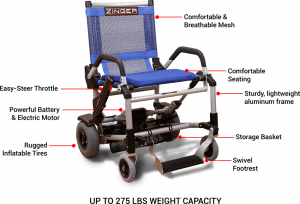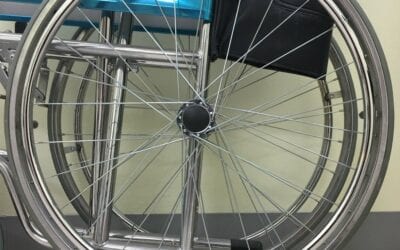The airlines damage passenger wheelchairs and lose mobility devices at a rate of more than 200 a week.
 When airlines damage passenger wheelchairs, it’s as if they’ve taken away the passenger’s legs. Fixing the problem is long overdue.
When airlines damage passenger wheelchairs, it’s as if they’ve taken away the passenger’s legs. Fixing the problem is long overdue.
U.S. Senator Tammy Duckworth (D-IL), a retired Army National Guard Lieutenant Colonel, was deployed to Iraq in 2004. While piloting a UH-60 Black Hawk helicopter, the helicopter was hit by a rocket-propelled grenade. Due to the attack, Captain Duckworth lost her right leg near the hip and her left leg below the knee. She needed extensive surgery on her right arm to save it.
In civilian life, Senator Duckworth had airlines damage passenger wheelchairs several times, the Senator said,
“I know from personal experience that when an airline damages a wheelchair, it is more than a simple inconvenience — it’s a complete loss of mobility and independence. It was the equivalent of taking my legs away from me again. No air traveler should be left in the lurch, immobile on a plane.”
Few understand the breadth of the airlines’ problem of losing and damaging passengers’ wheelchairs and scooters. Now we know just how serious it is.
 For years, disability rights groups told us that mobility-disabled travelers had to deal with damaged or lost wheelchairs and scooters regularly. Still, we didn’t know the breadth of the problem until recently. Senator Duckworth authorized an amendment to the FAA Reauthorization Act of 2018 requiring the airlines to report their mishandled wheelchairs and scooter statistics.
For years, disability rights groups told us that mobility-disabled travelers had to deal with damaged or lost wheelchairs and scooters regularly. Still, we didn’t know the breadth of the problem until recently. Senator Duckworth authorized an amendment to the FAA Reauthorization Act of 2018 requiring the airlines to report their mishandled wheelchairs and scooter statistics.
Now we know just how bad the problem is. In 2022, U.S. airlines reported 11,389 mishandled wheelchairs and scooters, up from 7,239 the year before, a 57 percent increase. During that time, the number of wheelchairs and scooters carried on U.S. airlines increased by 34 percent. The problem of lost or damaged wheelchairs and scooters is getting much worse.
Airlines are losing or damaging about 950 wheelchairs and scooters every month, and the problem is getting worse.
In more understandable terms, US airlines lose or damage about 950 wheelchairs and scooters monthly, more than 31 per day. On average, that’s more than 1.5 percent of the wheelchairs and scooters they handle annually. Spirit Airlines has the worst record. They lose or damage more than 5.7 percent of the wheelchairs and scooters they handle.
The stories of mobility-disabled passengers’ problems at the hands of the airlines are heartbreaking.
Reports tell us that when Andrew Gurza landed in San Francisco for a Cerebral Palsy Summit, he found that his custom-fitted power wheelchair was severely damaged and “sopping wet.” It was left in the rain on the tarmac. It worked, but the control bar was dislodged and hitting him when he used it. On his flight home, the wheelchair was further damaged.
When the airlines damage passengers’ wheelchairs, it’s no different than breaking passengers’ legs.
According to reports, Colleen Flanagan flew from Boston to Washington, D.C. When she landed she found that her power wheelchair was badly damaged. The joystick used to control the wheelchair was smashed. With the power switch missing, the wheelchair couldn’t be turned on and one side of the wheelchair was dented. She had to wait at the airport for three hours before an ill-fitting loaner wheelchair was brought to her.
As Ms. Flanagan said,
“There’s also that emotional part of like, wait a minute, you owe me. You literally stole my independence, my plans.”
Addie Loerzel took her first trip with her powered wheelchair earlier this year. She traveled from Minnesota to Maine. Reports state that when she arrived she found that her wheelchair was badly damaged. The panel with the power switch was sheared off, the frame was bent and other pieces were either out of place or completely missing. A fellow passenger got it temporarily going for her in Maine, but to date, there’s no timeline for the wheelchair’s repair, which includes fixing additional damage that occurred on the return flight to Minnesota.
There are sensible short term solutions to prevent wheelchair and scooter losses and damage that the airlines can implement immediately.
The problem needs to be quickly and comprehensively addressed by the airlines. I have some modest suggestions that can be immediately implemented.
1. The airlines should hire mobility-disabled travelers and advocates to work with them to develop policies, procedures, and methods that work. Right now, it’s clear that the airlines don’t know how to address the issues of mobility-disabled passengers.
2. The airlines need to create training for their flight crews and employees and contract workers who help disabled passengers at the airport and load/unload wheelchairs and scooters in the cargo holds of planes. A manual that details the proper way to handle the myriad of wheelchairs (powered or not) and scooters should be maintained at every airport.
3. For now, the airlines need to purchase and use the right loading/unloading equipment that can properly and safely handle powered wheelchairs and scooters that can weigh as much as 400 pounds.
4. The airlines should work with wheelchair and scooter manufacturers to develop cargo containers for wheelchairs and scooters with padding and strapping to secure the devices in the enclosed containers to prevent damage in-flight. Carefully detailed loading procedures should be developed so that the wheelchairs and scooters can be easily pushed into and out of the containers rather than lifted, during which much of the damage to wheelchairs typically occurs.
The airlines should look to implement long-term solutions that will achieve better results than the short-term ones offered above.
In the long term, airlines and aircraft manufacturers need to develop seating plans that will allow mobility disabled passengers to remain in their wheelchairs while onboard their flights. Already, Delta has displayed a new aircraft seat that will allow travelers to use their wheelchairs on planes. The seat folds to allow wheelchairs to be backed into it and gives access to their headrest, center console, tray table, and cocktail table to serve passengers with wheelchairs in place. The problem with this seat is that it clearly requires passengers to pay for and sit in first class.
Aircraft manufacturers must design aisles with seating that would also permit wheelchairs to at least access the first row in economy and permit wheelchairs to be located there during their flights.
For the totally wheelchair-bound passenger, aircraft designers and airlines need to design planes to allow mobility disabled passengers to get to an aircraft lavatory that has full handicap access.
Today, mobility-disabled passengers can help prevent their wheelchairs and scooters from being damaged by the airlines.
For now, mobility-disabled passengers can help themselves keep their wheelchairs (manual and powered) and scooters in good order by following the below suggestions.
1. Request the airline to stow manually operated wheelchairs in the aircraft cabin.
2. For wheelchairs and scooters stowed in the cargo hold, remove any attachments and put them in a bag that’s either checked or carried into the cabin.
3. Leave an instruction manual for baggage handlers to safely load/unload wheelchairs or scooters in the cargo hold.
 4. Disabled passengers should ensure they have the tools necessary to reassemble their wheelchairs and scooters.
4. Disabled passengers should ensure they have the tools necessary to reassemble their wheelchairs and scooters.
Hopefully, in the future, the airlines will act to be able to handle wheelchairs and scooters well and successfully. It shouldn’t be hard, and over the long haul, my suggestions will pay for themselves by eliminating the steep repair bills the airlines are currently incurring by damaging or losing more than 11,000 wheelchairs and scooters annually. It will also eliminate the substantial ill will they create daily. In the meantime, I strongly suggest mobility-disabled passengers help themselves with my four suggestions, found above.
READ ALSO:
Stupid travel mistakes and how to avoid them
Why good customer service suffers during post-COVID airline passenger crush
After many years working in corporate America as a chemical engineer, executive and eventually CFO of a multinational manufacturer, Ned founded a tech consulting company and later restarted NSL Photography, his photography business. Before entering the corporate world, Ned worked as a Public Health Engineer for the Philadelphia Department of Public Health. As a well known corporate, travel and wildlife photographer, Ned travels the world writing about travel and photography, as well as running photography workshops, seminars and photowalks. Visit Ned’s Photography Blog and Galleries.



